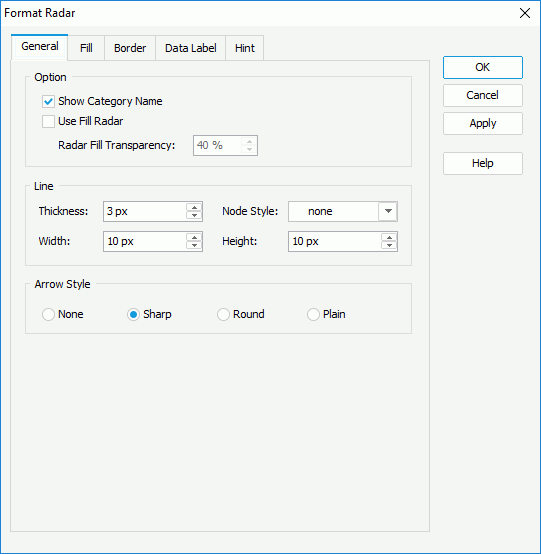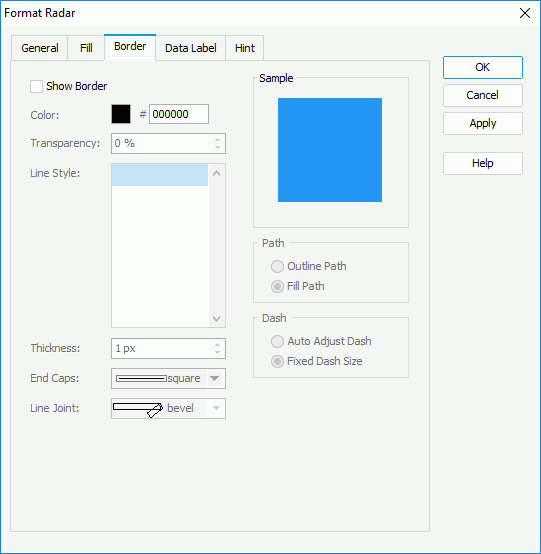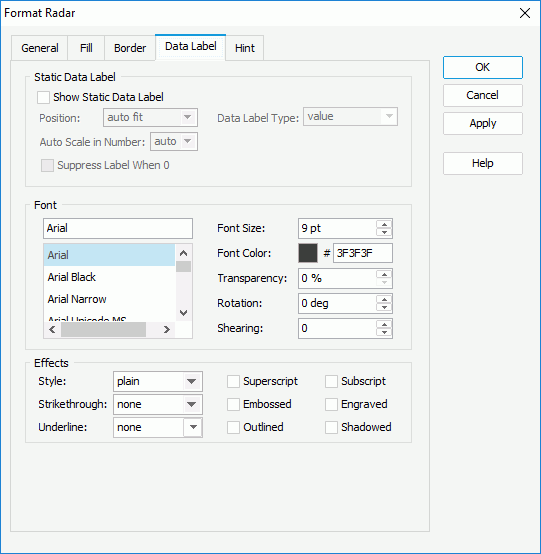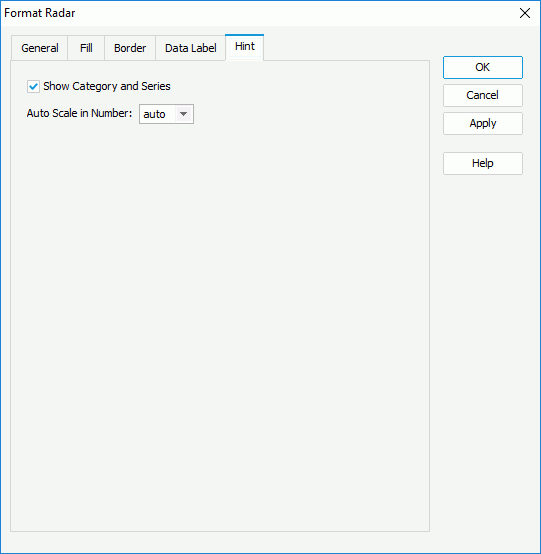Format Radar Dialog Box
You can use the Format Radar dialog box to format the radar in a radar chart. This topic describes the options in the dialog box.
Designer displays the Format Radar dialog box when you right-click any line which connects two value nodes in a radar chart and select Format Radar from the shortcut menu, or double-click any line connecting two value nodes in a radar chart.
This dialog box contains the following tabs:
Designer displays these buttons in all the tabs:
OK
Select to apply your settings and close the dialog box.
Cancel
Select to close the dialog box without saving any changes.
Apply
Select to apply all changes and leave the dialog box open.
Help
Select to view information about the dialog box.
General Tab
Use this tab to specify general properties of the radar chart.

Options
You can specify the radar chart options in this box.
- Show Category Name
Select to show the category names in the radar chart. - Use Fill Radar
Select to fill the areas formed by value nodes of a same data series in the radar.- Radar Fill Transparency
Specify the transparency of the areas.
- Radar Fill Transparency
Line
You can specify properties of the lines connecting the value nodes in the radar in this box.
- Thickness
Specify the thickness of the lines, in pixels. - Node Style
Select the style of the nodes on the lines. - Width
Specify the width of the nodes on the lines, in pixels. - Height
Specify the height of the nodes on the lines, in pixels.
Arrow Style
You can specify the style of the arrows on the numeric axes in the radar in this box.
- None
Select to apply no style to the arrows. - Sharp
Select to use sharp arrows. - Round
Select to use round arrows. - Plain
Select to use plain arrows.
Fill Tab
Use this tab to specify the fill pattern of the radar areas.

Color
Specify the color of the selected radar areas in the same data series. To edit the color, select the color indicator and select a color from the color palette, or type the hexadecimal value of a color (for example, 0xff0000) in the text box.
Transparency
Specify the transparency of the color.
Self Settings
Select to apply the color pattern to the radar areas themselves only. When this option is cleared, Designer synchronizes the color pattern that you specify here with the Pattern List property of the chart in the Report Inspector, which data markers of other subtypes can also apply if the chart is a combo chart.
Color List
Select to open the Color List dialog box to modify the color pattern for radar areas in the same data series respectively.
Sample
This box displays a preview sample based on your selections.
Border Tab
Use this tab to specify properties for the border of the radar areas.

Show Border
Select to show the border of the radar areas. Designer enables the other border properties in this tab after you select this option.
Color
Specify the color of the border. To edit the color, select the color indicator and select a color from the color palette, or type the hexadecimal value of a color (for example, 0xff0000) in the text box.
Transparency
Specify the transparency of the border.
Line Style
Select the line style of the border.
Thickness
Specify the width of the border, in pixels.
End Caps
Select the ending style of the border.
- butt
Select to end unclosed subpaths and dash segments with no added decoration. - round
Select to end unclosed subpaths and dash segments with a round decoration that has a radius equal to half of the line width. - square
Select to end unclosed subpaths and dash segments with a square projection that extends beyond the end of the segment to a distance equal to half of the line width.
Line Joint
Select the joint style of the border.
- miter
Select to join path segments by extending their outside edges until they meet. - round
Select to join path segments by rounding off the corner at a radius of half the line width. - bevel
Select to join path segments by connecting the outer corners of their wide outlines with a straight segment.
Sample
This box displays a preview sample based on your selections.
Path
You can specify the fill pattern of the border in this box.
- Outline Path
Select to use outline path for the border. - Fill Path
Select to use whole path for the border.
You can specify the dash size of the border in this box if you select a dash line style for the border.
- Auto Adjust Dash
Select to adjust the dash size automatically. - Fixed Dash Size
Select to use fixed dash size.
Data Label Tab
Use this tab to specify properties of the data labels on the radar.

Static Data Label
You can specify properties of the static data labels on the radar in this box.
- Show Static Data Label
Select to show the static data labels. Designer enables the other static data label properties after you select this option. - Position
Select the position of the static data labels on the radar.- auto fit
Select to display the static data labels automatically.
- auto fit
- Data Label Type
Select in which way to display the values in the static data labels.- value
Select to show the value for each value node. - percent
Select to show the percentage of each value node to the total. - value and percent
Select to show the value and the percentage for each value node.
- value
- Auto Scale in Number
Specify whether to automatically scale the Number values in the static data labels that fall into the two ranges:- When 1000 <= value < 10^15, Designer applies the following quantity unit symbols of the International System of Units to scale the values: K (10^3), M (10^6), G (10^9), and T (10^12).
- When 0 < value < 0.001 or value >= 10^15, Designer uses scientific notation to scale the values.
By default, Designer selects "auto" for the option, meaning, Designer applies the setting that you specify for the same property on the chart in the Report Inspector for the values. If you select "true", Designer applies the specified format to the integer part of the values after scaling them; however, if the specified format conflicts with the logic of Auto Scale in Number, for example, the values display in percentage, Designer ignores the Auto Scale in Number setting. Select "false" if you do not want to scale the values.
- Suppress Label When 0
Select if you do not want to display the static data label when its value is 0.
Font
You can specify the font style of the text in the static data labels in this box.
- Font list
This drop-down list contains all the font faces you can select to apply to the text. - Font Size
Specify the font size of the text. - Font Color
Specify the font color of the text. To edit the color, select the color indicator and select a color from the color palette, or type the hexadecimal value of a color (for example, 0xff0000) in the text box. - Transparency
Specify the transparency of the text. - Rotation
Specify the rotation angle of the text around its center, in degrees. The default value is 0. - Shearing
Specify the gradient of the text.
Effects
You can specify the special effects for the text in the static data labels in this box.
- Style
Select the font style of the text. It can be one of the following: plain, bold, italic, and bold italic. - Strikethrough
Select the style of the horizontal line using which to strikethrough the text. It can be one of the following: none, thin line, bold line, and double lines. - Underline
Select the style of the horizontal line under the text. It can be one of the following: none, single, single lower, bold line, bold lower, double lines, bold double, patterned line, and bold patterned. When you select "patterned line" or "bold patterned", Designer draws a line or bold line in the pattern of the text. - Superscript
Select to raise the text above the baseline and change the text to a smaller font size, if a smaller size is available. - Subscript
Select to lower the text below the baseline and change the text to a smaller font size, if a smaller size is available. - Embossed
Select to make the text appear to be raised off the page in relief. - Engraved
Select to make the text appear to be imprinted or pressed into the page. - Outlined
Select to display the exterior border around each character of the text. - Shadowed
Select to add a shadow beneath and to the right of the text.
![]() Web Report Studio and JDashboard do not support underlining chart text, therefore, this property is ignored when the chart runs in Web Report Studio or is used in a dashboard.
Web Report Studio and JDashboard do not support underlining chart text, therefore, this property is ignored when the chart runs in Web Report Studio or is used in a dashboard.
Hint Tab
Use this tab to specify properties for the hint of the radar.

Show Category and Series
Select to include the category and series values in the hint.
Auto Scale in Number
Specify whether to automatically scale the Number values in the hint that fall into the two ranges:
- When 1000 <= value < 10^15, Designer applies the following quantity unit symbols of the International System of Units to scale the values: K (10^3), M (10^6), G (10^9), and T (10^12).
- When 0 < value < 0.001 or value >= 10^15, Designer uses scientific notation to scale the values.
By default, Designer selects "auto" for the option, meaning, Designer applies the setting that you specify for the same property on the chart in the Report Inspector for the values. If you select "true", Designer applies the specified format to the integer part of the values after scaling them; however, if the specified format conflicts with the logic of Auto Scale in Number, for example, the values display in percentage, Designer ignores the Auto Scale in Number setting. Select "false" if you do not want to scale the values.
Customize Chart Value Names
Select to customize the names of the fields on the value axis which you want to display in the hint. By default, Designer applies the display names of the fields in the hint to label the values which may be not intuitive to users. You can select the option and select the ellipsis  to customize the names in the Customize Chart Value Names dialog box to help users better understand the values.
to customize the names in the Customize Chart Value Names dialog box to help users better understand the values.
 Previous Topic
Previous Topic